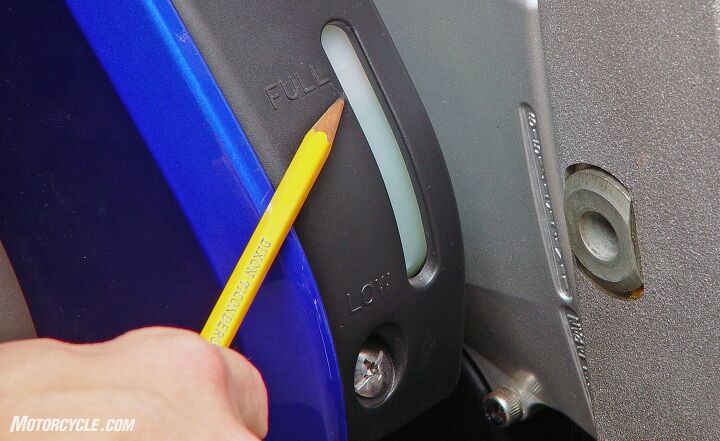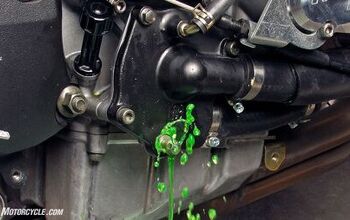MO Wrenching: How Do I Check My Coolant?

Checking one of the most vital fluids in your motorcycles engine
Well, I’m glad you asked, Grasshopper.
Coolant is almost as vital to your bike’s engine as oil. Run your engine without some kind of coolant, and you risk extensive damage. (Yes, there are true stories of hapless racers who’ve run several laps around the high banks of Daytona with dry cooling systems and done no measurable damage to the engine, but would you like to gamble with your $10,000 investment?) Now, I’ll follow with a question of my own: What exactly do you want to investigate? There are two coolant checks we’ll look at here.
The first is the simplest: Does my bike have enough coolant in it? A nice side benefit of a cursory glance at the coolant overflow tank is that it will tell you if everything is working right. You want the level to lie between the high and low marks when the engine is cold. The color should be a lovely fluorescent green. If oil or a rust-colored hue appear in the coolant, your engine may be telling you it has a problem that needs attention.
The second isn’t much more difficult, although, on some bikes, it may involve a little wrenching before you can check the condition of your cooling system’s life blood. Unfortunately, when many riders think of coolant, they only think of “antifreeze.” While protecting your engine from freezing during winter storage is important (and presumably why we’re posting this, now, the week before Christmas), antifreeze also performs several other important duties. The aluminum internals to your engine are prone to oxidizing. Coolant and other products, such as Water Wetter, form a protective coating over the bare aluminum, keeping it from eroding at high-heat areas and from building up on cooler locations, which would reduce the efficiency of the cooling system. Coolant also lubricates the water pump and prevents foaming.
If all of this is so critical to a bike’s health, why do racing organizations prohibit the use of it? Ethylene-glycol-based coolants have two characteristics that can cause big problems on the track: They are extremely slippery and are tough to clean from pavement.
Street riders, however, would gain nothing from running their engines without coolant. In fact, those living in northern climes would be nuts not to protect their bike from the cold season. Additionally, you should test your antifreeze annually to make sure it will handle the cold. Changing the coolant every two years is also a good idea. Although the overflow tank is the easiest to access, why not spend the extra time to expose the cooling system filler cap so you can test what’s actually inside the engine?
So, with your engine cold (a hot cooling system is under pressure and will spew potentially injurious coolant all over the place.), remove the filler cap. For the actual testing, you have a couple of choices. Prestone makes clever throw away test strips that you dip into the coolant, read the color, then toss into the trash. You can also use a testing tool that measures the specific gravity of the solution and displays the results with floating balls or a needle. While you’re at it, check the color of the coolant. If it looks like Mountain Dew, it’s probably OK. Other colors, like rust (red-brown) or oil (black) residue, may signal engine problems.
If the coolant passes the tests, it’s good to go for the winter. If not, consider changing the it – a topic we’ll take up in the near future.

Like most of the best happenings in his life, Evans stumbled into his motojournalism career. While on his way to a planned life in academia, he applied for a job at a motorcycle magazine, thinking he’d get the opportunity to write some freelance articles. Instead, he was offered a full-time job in which he discovered he could actually get paid to ride other people’s motorcycles – and he’s never looked back. Over the 25 years he’s been in the motorcycle industry, Evans has written two books, 101 Sportbike Performance Projects and How to Modify Your Metric Cruiser, and has ridden just about every production motorcycle manufactured. Evans has a deep love of motorcycles and believes they are a force for good in the world.
More by Evans Brasfield































Comments
Join the conversation
COOL
Nice ...